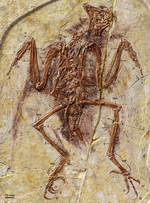Cranial kinesis is the term for significant movement of skull bones relative to each other in addition to movement at the joint between the upper and...
19 KB (2,452 words) - 19:19, 5 February 2024
Birds show independent movement of the skull bones known as cranial kinesis. Cranial kinesis in birds occurs in several forms, but all of the different...
82 KB (9,632 words) - 01:56, 18 July 2024
ancestors, enabling them to swallow prey much larger than their heads (cranial kinesis). To accommodate their narrow bodies, snakes' paired organs (such as...
151 KB (15,099 words) - 16:28, 8 July 2024
Stan's skull has enabled scientists to learn more about the T. rex's cranial kinesis, or movement of the skull bones, than any other T. rex specimen. Because...
21 KB (2,342 words) - 15:03, 19 July 2024
reproduction coefficient. The models of kinesis were tested with typical situations. It was demonstrated that kinesis is beneficial for assimilation of both...
5 KB (607 words) - 03:31, 30 April 2024
also thought that early avialans were either cranially akinetic or had otherwise limited cranial kinesis. Avialans diversified into a wide variety of...
18 KB (1,628 words) - 01:32, 30 June 2024
quadrate, or maxilla. The snake skull shows the greatest degree of cranial kinesis, which allows the snake to swallow large prey items. In mammals, the...
8 KB (847 words) - 01:17, 7 May 2024
here) cranial kinesis Cranial kinesis is the ability of parts of the skull to move against each other at joints within the skull. Though cranial kinesis had...
158 KB (16,384 words) - 14:03, 2 June 2024
downcurved. Like all birds, the bills of sandpipers are capable of cranial kinesis, literally being able to move the bones of the skull (other than the...
16 KB (1,598 words) - 21:21, 30 June 2024
(December 12, 2008). "Cranial kinesis in dinosaurs: intracranial joints, protractor muscles, and their significance for cranial evolution and function...
84 KB (9,733 words) - 05:46, 20 June 2024
sturgeons and fossil paddlefish, were capable of protrusion, a form of cranial kinesis allowing them to move relative to the rest of the skull, with the upper...
32 KB (3,275 words) - 07:02, 29 June 2024
heterodontosaurids as basal pachycephalosaurs on the basis of perceived cranial kinesis, the presence of fanglike premaxillary teeth, and the prominent diastema...
40 KB (3,581 words) - 19:47, 21 July 2024
sheathes. The skull also exhibits features consistent with significant cranial kinesis: a synovial joint between the braincase and the frontals and a loose...
7 KB (722 words) - 14:19, 16 June 2024
non-overlapping bones. This is believed to have facilitated the evolution of cranial kinesis in birds which has played a critical role in their ecological success...
35 KB (3,809 words) - 04:43, 24 May 2024
fenestration (the shape of holes in the skull behind the eye) and cranial kinesis (the flexibility of joints within the skull). One idea was that Tanystropheus...
117 KB (12,837 words) - 15:33, 29 June 2024
Joshua B Smith, Matthew Lamanna, Allison Tumarkin-Deratzian (2004) Cranial Kinesis and Diet in Mawsonia (Actinistia, Coelanthiformes) Cavin, Lionel; Boudad...
12 KB (1,193 words) - 04:00, 27 May 2024
the ability to have high speed jaw opening (high kinesis) or higher bite transmission (lower kinesis). While there is a more complex relationship between...
26 KB (3,166 words) - 06:53, 1 March 2024
upper jaw of Squamates is movable on the cranium, a configuration called kinesis. This is made possible by a loose connection between the quadrate and its...
30 KB (3,256 words) - 06:06, 15 June 2024
LeBlanc; Michael W. Caldwell; Johan Lindgren (2013). "Aquatic adaptation, cranial kinesis, and the skull of the mosasaurine mosasaur Plotosaurus bennisoni"....
12 KB (1,350 words) - 15:21, 21 May 2024
marginal, median, etc.—see broadly wing coverts and tail coverts. cranial kinesis Also defined: prokinesis, amphikinesis and distal rhynchokinesis. Movement...
288 KB (31,013 words) - 20:14, 19 July 2024
tendenze evolutive. Part II – Striges, Caprimulgiformes ed Apodiformes ["Cranial kinesis and morphology of non-passerine birds. Study of various evolutionary...
10 KB (912 words) - 00:17, 3 January 2024
hands and feet rather than its jaws. Welles did not find evidence of cranial kinesis in the skull of Dilophosaurus, a feature that allows individual bones...
119 KB (14,581 words) - 00:31, 2 May 2024
Junggarsuchus (section Post-Cranial Skeleton)
of the skull, Clark and colleagues noted that there was very little cranial kinesis and there were attachment sites for very powerful jaw muscles, which...
45 KB (4,677 words) - 04:16, 29 April 2024
skeleton, including a flat or shallow skull, a fused skull roof with no cranial kinesis, exoccipital-postparietal contact on the occiput, and four or fewer...
8 KB (897 words) - 13:37, 1 May 2024
Osmólska and colleagues suggested that Gallimimus was capable of cranial kinesis (due to the seemingly loose connection between some of the bones at...
68 KB (7,885 words) - 12:43, 9 June 2024
2012-04-02. Olsen, A.M. (3–7 Jan 2012). Beyond the beak: Modeling avian cranial kinesis and the evolution of bird skull shapes. Society for Integrative & Comparative...
83 KB (9,174 words) - 04:19, 23 May 2024
skull would have rendered the Enantiornithes capable of only limited cranial kinesis (the ability to move the jaw independent of the cranium). As a very...
107 KB (8,728 words) - 21:39, 9 July 2024
quadrate bone (c) is particularly elongated in snakes, to facilitate cranial kinesis. Courtesy of the Peabody Museum of Natural History, Division of Vertebrate...
5 KB (490 words) - 18:55, 27 December 2023
Lawrence M. (2008). "Cranial kinesis in dinosaurs: intracranial joints, protractor muscles, and their significance for cranial evolution and function...
106 KB (11,734 words) - 05:22, 26 June 2024
endocranium is hinged, the hinge forming the profundus nerve foramen. The cranial kinesis is also visible in the skull roof, between the parietal bones and the...
14 KB (1,110 words) - 19:12, 14 July 2024

























